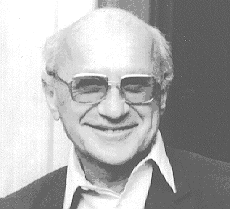Milton Friedman


This is a brief biography of Milton Friedman, who in 1976 received
the Nobel prize...
"...for his achievements in the field of consumption analysis, monetary history and theory and for his demonstration of the complexity of stabilisation policy."
Background
Like many other famous Americans, Milton Friedman is the son of poor immigrants. He was born in New York City in 1912, and his father died when he was only 15. Nonetheless, Friedman managed to get a Bachelor of Arts degree from Rutgers University in 1932 and an AM from Chicago one year later. He started out working as a research assistant at Chicago with demand analysis, and in 1937 he started an association with the National Bureau of Economic Research which lasted until 1981. Another long association begun around that time was with his wife, Rose Director. His two children show a strong causal correlation with this association. In 1946, Friedman received his PhD from Columbia, the same year in which he became a professor of economics at Chicago.
The Statistical Years
These years were spent working with statistics, and many consider some of Friedman's impressive contributions to come from this period. He developed the use of rank order statistics to avoid making the assumption of normality in the analysis of variance in 1937, in a paper which is still regarded as critical to the development of non-parametric methods of variance analysis. He spent most his time analyzing data on incomes and expenditures, which gave him an unusually solid grounding in the basic empirical material of economics. During wartime service in the statistical research group, Friedman formulated the basic idea of what later became called sequential sampling, which became the basis for quality control inspection.
By the end of World War II, Friedman clearly could have continued
working as a statistician and would surely have achieved high
renown within this area, and he could also have become
influential in the fast growing field of econometrics. Yet his
"excursions" into statistics were more utilitarian than
speculative, and his contributions to the field were linked with
his strong belief that economics can acquire plausibility only by
being subjected to empirical verification.
Consumption Theory
In 1953, Friedman wrote an essay called Methodology of Positive Economics in which he argued that theories should be proven only by the correspondence of the predictions and facts, not between the correspondence between empirical correlates and assumptions. This produced enormous controversy, but has had a lasting effect. What many regard as Friedman's greatest work, A Theory of the Consumption Function, was published in 1957, and in this he pointed out regression fallacy and other flaws in Keynes's General Theory of the regularity and predictability of the consumption function. He suggested that people rather tend to adjust their consumption on the basis of variations in their long term expected income. The book gave a new standard for empirical economics generally by showing how studies should be done, as well as introducing the concept of permanent income into almost every field of applied economics.
Expected Utility
Friedman also developed the expected utility, and apart from rationalizing the widespread practice of simultaneously gambling an insuring, the hypothesis had a profound effect on the theory and practice of portfolio selection and choices between risky alternatives. This was basically Friedman's last contribution to the pure theory of statistics and decision making, and many statisticians regard "the diversion of such a fertile mind" as a great loss.
Economic Theory
Yet others argue that the analysis of economic policy, and particularly the critique of the logical structure of the arguments and the empirical evidence adduced to support proposals on economic policy, was more important. Freedman's work the next thirty years focused on studies of money , such as showing the inferiority of excise taxes compared to income taxes, the uses and abuses of the theory of price, the theory of human capital, etc.
In a monumental work A Monetary History of the United States, 1867-1960 (1963), Friedman explained that a stable growth of money supply is infeasible under a regime of fixed exchange rates. His advocacy of flexible exchange rates followed his contra-Keynesian view of the efficacy of free markets. Yet in spite of increasing attention to the balance of payments and the money supply process, the prime focus of Friedman's work was the examination of the effects of monetary variations on nominal income, prices and output. In essence, Friedman found that variations in the rate of growth of the money supply had short run effects, but in the long run (more that three years) the only substantial effect was on prices.
Unemployment vs. Inflation
In 1968 Friedman showed that the view of macroeconomic policy as a trade-off between unemployment and inflation was fundamentally flawed and that in the long run there was no such trade-off while in the short run the trade-off took place only during the adjustment to the new inflationary environment. This idea caught on and was proven true as unemployment went up and inflation did not go down through all through the early seventies.
The Nobel Prize
Long overdue, in 1976 Friedman was awarded the Nobel Prize for Economics. The conventional view of Friedman is that he has been one of the most ardent and most effective advocates of free enterprise and monetarist policies over the four decades 1945-1985. The success of his advocacy has been enormous, and opinion in Western countries, even among the clerisy, has moved decisively in its preference for those economic freedoms that he so eloquently advocated. In effectiveness, breadth and scope, his only rival among the economists of the 20th century is Keynes.
Source: Alan Walters, A Dictionary of Economics, The New Palgrave,
Vol. 2 , 1987, pp 422-427.